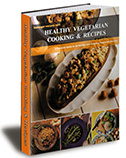Meats, Poultry, and Seafood
Cooking meats gently enough to retain vitamins and minerals while reducing the saturated fat content is tricky business. The leanest cuts of red meats, which are the most healthful, usually are prepared using long cooking times and moist heat, such as pot roasting, stewing, and braising. These methods result in greater loss of thiamin, niacin, and riboflavin into the cooking liquid. (Many of these water-soluble vitamins, however, can be obtained from other sources, such as whole-grain breads.) If the cooking liquid is used as a gravy or sauce, some of the vitamins are saved. If time permits, the liquid should be cooled so the fat can be skimmed off. Faster cooking methods, such as broiling, frying, and roasting allow the meat to retain more of its vitamins.
Thiamin and several other minerals are sensitive to high heat, so meats that are rare may be richer sources than well-done meats. Pork, however, should never be served rare because it must be cooked long enough to kill harmful organisms. (Pork must reach a core temperature of 150 to 160 degrees F.)
Excess fat should be trimmed off of red meat before and after cooking. With poultry, the skin, which is primarily fat, and the fatty deposits under the skin and around the tail can be removed before cooking if a moist, slow method is used. Skin can also be removed before serving. Skin, however, is often considered a tasty part of a chicken. The choice of whether to eat it could depend on the amount of fat in the rest of the meal or the family’s diet in general. Serving chicken dishes that use cheese, tomato sauce, herbs and spices, sauces, vegetables, and pasta can be a good way to get rid of the skin and fat and still serve a nourishing chicken dish the family will enjoy.
Charcoal broiling is another way to reduce the fat content of meats. Research shows, however, that charcoal smoking (as opposed to broiling) for a long time may lead to the formation of carcinogens in red meat, chicken, and fish. Meats can be partially baked or parboiled before they are placed on the grill to reduce the amount of smoking. This is especially effective for chicken, which takes a long time to cook on the grill. Keeping the lid of the grill open while charcoal broiling meats decreases
the amount of smoke.
Other Food Preparation Tips
Rice and pasta should not be rinsed with fresh water after they are cooked because many of the vitamins and minerals that are released into the cooking water cling to their surface as the water is absorbed.
The amounts of sugar, salt, shortening, and oils that are called for in recipes usually can be reduced significantly without affecting the final product. Also, when recipes require milk or cream, skim milk, low-fat milk, or buttermilk often can be used to reduce the level of saturated fat. Careful experimenting will show how this can be done.
Low-fat yogurt can be substituted for sour cream for most dishes.
When cooking with eggs, it is a good idea to use more egg whites and fewer egg yolks. Yolks are high in cholesterol and fat, while egg whites are low in cholesterol, fat, and calories and are good sources of high-quality protein (albumin). (The unused raw egg yolks can be fed to cats and dogs and will help keep their coats shiny and healthy.) Again, whether to eat a lot of egg yolks can be put into the context of a family’s overall fat and cholesterol consumption.
Cooking in microwave ovens is fast and will lead to small vitamin and mineral losses.
Heavy cookware generally will distribute the heat more evenly and help prevent burning. Skillets made of iron may destroy some vitamins in food; however, cooking in this type of pan will add iron to the diet. Copper and brass pots must be well lined because food can absorb these metals, and large amounts can be harmful. In addition, copper and brass can destroy valuable vitamins. Glass pots let in light, and small amounts of riboflavin, which is sensitive to light, can be lost. Using nonstick cookware can be a good way to decrease the level of fat in the diet because pots and pans do not have to be greased before they are used. Stainless steel, a mixture of iron and other metals, can cause problems for people who are allergic to some kinds of metal. Also, starchy foods can stain the surface, and salt residues can slowly eat through the surface.
Aluminum pots and pans should not be used to cook salty, acid, or alkaline foods because the metal may dissolve and get into food. In addition, aluminum can cause vegetables, such as cabbage, Brussels sprouts, cauliflower, and broccoli, to take on too strong a smell during cooking. Aluminum also can hurt appearance by turning food that is supposed to be white to yellow, orange, or brown. Although some have suggested a link between Alzheimer’s disease and aluminum, studies so far have failed to show a strong connection.
For new ideas on cooking delicious and healthy food, visit lowsugar-recipes.com.
